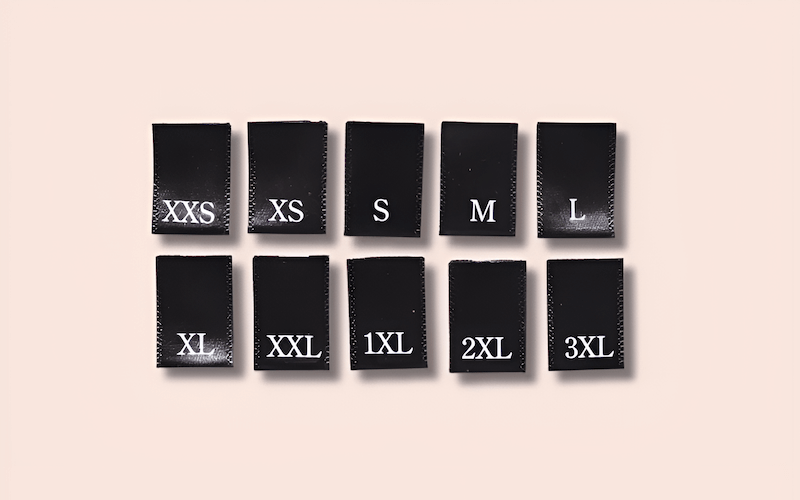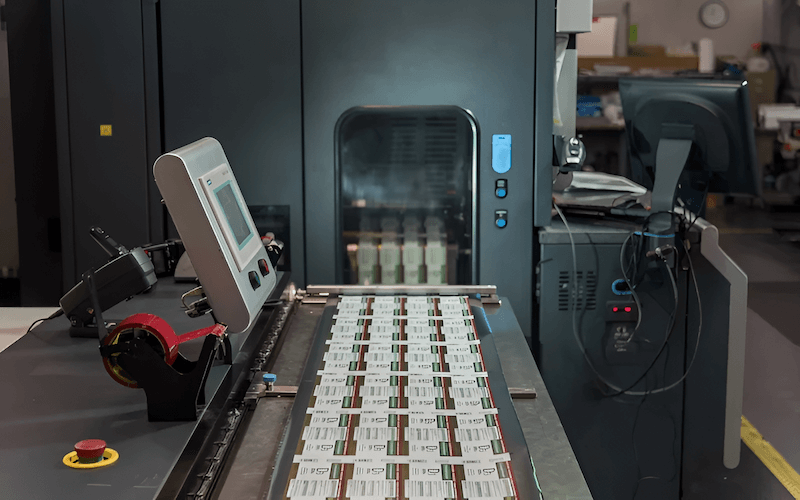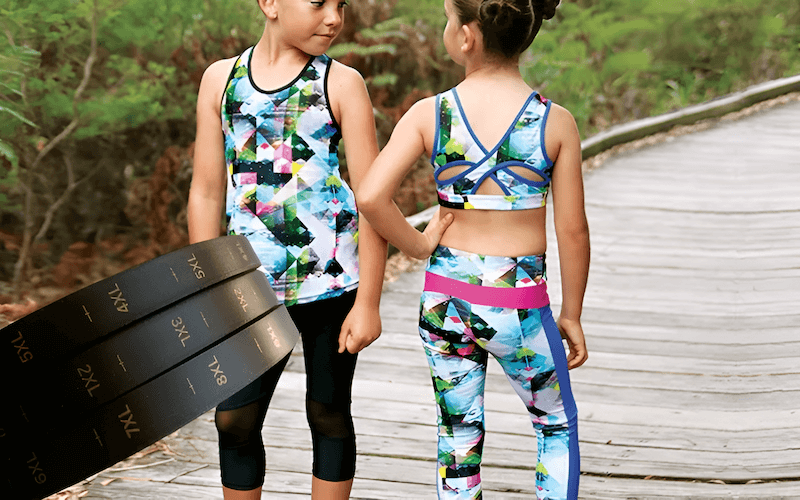Woven vs Printed Size Labels: Which is Best for Your Brand?
In the apparel industry, the smallest details often make the biggest difference. Size labels, those seemingly insignificant tags inside garments, play a crucial role not only in guiding customers to the right fit but also in reinforcing brand identity and enhancing the overall customer experience.
Selecting the appropriate size label isn’t just about displaying a number or letter; it’s a strategic decision that impacts how customers perceive a clothing brand. This article helps clothing brands to make the right decision.
This guide will delve into the two primary types of size labels: woven and printed. By comparing and contrasting their characteristics, we aim to equip apparel businesses with the knowledge needed to choose the best option for their specific needs, ensuring both customer satisfaction and a cohesive brand presentation.
1. What are woven size labels?
Woven size labels are a classic choice in the apparel industry, known for their durability and high-end feel. These labels are created using a weaving process on a Jacquard loom, a specialized machine that intricately interlaces threads to form the label’s design, including the size information, logo, and any other desired text or imagery.
Here’s a closer look at woven size labels:
Weaving Process: The Jacquard loom uses a system of punched cards (or, more commonly today, computer software) to control the lifting and lowering of individual warp threads (the lengthwise threads). This allows for precise and detailed designs to be woven directly into the fabric of the label.
Common Materials:
- Polyester: The most popular choice due to its exceptional durability, resistance to shrinking and stretching, and colorfastness. Polyester woven labels can withstand numerous wash cycles without significant wear.
- Damask: A type of weave that uses finer threads and a tighter weave structure, resulting in a smoother, more luxurious feel and enhanced detail. Damask is often considered a premium option within woven labels.
- Cotton: A natural fiber option that offers a softer, more organic feel. While cotton woven labels can be very comfortable against the skin, they may be slightly less durable than polyester and more prone to fading over time.
Key Characteristics:
- Durability: Woven labels, especially those made from polyester, are exceptionally durable. The design is integral to the label’s structure, making it highly resistant to fading, fraying, and general wear and tear.
- Textured Feel: Woven labels have a distinct tactile quality. The raised threads create a texture that can be felt, adding a subtle but noticeable element of quality.
- High-End Perception: Because of their durability and textured feel, woven labels are often associated with higher-quality garments and brands. They convey a sense of craftsmanship and attention to detail.
- Wash Resistance: Woven labels are designed to withstand repeated washing and drying without significant degradation. The woven design is less susceptible to damage compared to printed designs.

2. What are printed size labels?
Printed size labels offer a versatile and cost-effective alternative to woven labels. Instead of weaving threads, these labels utilize a digital printing process to apply the design directly onto the surface of the label material.
Here’s a breakdown of printed size labels:
Printing Process: Digital printing is the most common method for creating printed size labels. This process uses specialized inkjet printers designed for fabric, applying ink directly onto the label material. Other printing methods, such as screen printing (applying ink through a stencil) and flexographic printing (using flexible relief plates), can also be used, but digital printing offers the greatest design flexibility and is ideal for short runs and variable data.
Common Materials:
- Satin: A popular choice for printed labels due to its smooth, lustrous surface, which allows for sharp and vibrant prints. Satin labels have a luxurious feel but may be less durable than other options.
- Cotton: A natural fiber option that provides a softer, more matte finish. Cotton printed labels are comfortable against the skin but may be more prone to fading than synthetic materials.
- Polyblend: A blend of polyester and cotton, offering a balance of durability, softness, and printability. Polyblend labels can be a good compromise between cost and performance.
Key Characteristics:
- Smooth Texture: Printed labels have a completely smooth surface, as the design is applied on top of the material rather than woven into it.
- Design Versatility: Printed labels excel in reproducing photographs, gradients, and fine details. The digital printing process allows for virtually unlimited color options and intricate patterns.
- Cost-Effectiveness: Printed labels are generally more affordable than woven labels, especially for smaller quantities. The printing process is faster and requires less specialized equipment.
- Complex design: Printed labels easily handle extremely complex designs.

3. Key differences: Woven vs. printed size labels
3.1 Durability and wash resistance
Woven and printed size labels differ significantly in their durability and resistance to washing. Woven labels, with their design integrated into the fabric’s weave, generally exhibit superior longevity. The threads are tightly interwoven, making them highly resistant to fading and fraying, even after numerous wash cycles. This inherent durability makes woven labels ideal for garments that experience frequent washing and wear.
Printed labels, on the other hand, have the design applied to the surface of the material. While modern printing techniques and inks offer good wash resistance, they are inherently more susceptible to wear over time. Depending on the specific ink, material, and washing conditions, printed labels may show signs of fading or cracking after repeated washes. The longevity of a printed label is often tied to the quality of the printing process and the materials used.

3.2 Design complexity and detail
The ability to render intricate designs and fine details is a key differentiator between woven and printed labels. Printed labels hold a significant advantage in this area. Digital printing technology allows for the reproduction of highly complex designs, including photographs, gradients, and very small text. Printed labels can achieve a level of detail that is simply not possible with weaving. For instance, printed labels can comfortably accommodate text down to 5pt or even smaller, ensuring readability even for fine print.
Woven labels, while capable of creating clear and crisp designs, are better suited for simpler graphics, logos, and larger text. The weaving process has inherent limitations in terms of the fineness of detail it can achieve. Typically, woven labels require text to be above 10pt for optimal clarity. Intricate patterns or very small elements may appear blurred or pixelated when woven.

3.3 Texture and feel
Texture and feel are important sensory aspects of a label that can influence the perception of quality. Woven labels have a distinct tactile quality due to the raised threads of the weave. This texture can range from slightly rough to relatively smooth, depending on the specific weave and materials used (e.g., damask weaves offer a smoother feel). This textured surface can contribute to a perception of higher quality and a more luxurious feel.
Printed labels, in contrast, are inherently smooth. The design is printed onto the surface of the material, resulting in a flat, textureless finish. While this smoothness can be desirable in certain applications, it may lack the tactile richness associated with woven labels. The choice between the two often depends on the desired brand image and the overall aesthetic of the garment.
3.4 Cost and production time
Cost and production time are practical considerations that often influence the choice between woven and printed labels. Woven labels generally have a higher per-unit cost and longer production lead times. This is due to the more complex and time-consuming weaving process, which requires specialized equipment (Jacquard looms) and skilled operators. The setup for weaving can also be more involved, contributing to higher initial costs.
Printed labels, particularly those produced using digital printing, are typically more cost-effective and have faster turnaround times. The printing process is relatively quick and requires less specialized equipment. This makes printed labels an attractive option for businesses with budget constraints or tight deadlines. The lower setup costs also make printed labels suitable for smaller production runs.
3.5 Material options
| Feature | Woven Labels | Printed Labels |
|---|---|---|
| Material | Primarily polyester, damask (a type of polyester weave), cotton. | Satin, cotton, polyblend (polyester-cotton mixes). |
| Cost | Generally more expensive due to the weaving process. | Generally more affordable, especially for smaller quantities. |
| Smooth | Offer textured | Offer a smooth surface |
3.6 Use cases
High-End Boutique Clothing:
- Problem: A high-end boutique specializing in luxury apparel needs labels that reflect the quality and exclusivity of their garments. The labels must be durable, feel luxurious, and complement the overall brand aesthetic.
- Solution: Woven labels are the ideal choice. Their textured feel, durability, and association with high-end brands make them a perfect match for luxury clothing. The boutique can choose a damask weave for a smoother, more refined texture.
Children’s Clothing Line:
- Problem: A children’s clothing brand prioritizes comfort and safety. The labels must be soft against the skin, non-irritating, and able to withstand frequent washing. The designs often include playful graphics and bright colors.
- Solution: Printed labels on soft cotton or a polyblend material are a good option. The smooth surface of printed labels minimizes the risk of irritation, and the printing process allows for vibrant, colorful designs.
Lingerie Brand:
- Problem: A lingerie brand requires labels that are delicate, discreet, and comfortable against the skin. The labels need to convey a sense of elegance and sophistication, but they should not be bulky or detract from the garment’s design. Intricate designs may also be needed.
- Solution: Printed labels on satin offer a smooth, luxurious feel that complements delicate fabrics. The printing process allows for fine details and intricate designs, maintaining the brand’s aesthetic.
Activewear Company with Complex Logo:
- Problem: An activewear company has a logo with intricate details and color gradients. The labels need to be durable enough to withstand sweat and frequent washing, and they must accurately represent the brand’s logo.
- Solution: Printed labels are the best choice for reproducing the complex logo with its gradients and fine details. A polyblend material can offer a balance of durability and printability.

4. Choosing the right label for your brand
4.1 Consider your brand identity
The choice between woven and printed size labels should be a conscious reflection of a clothing brand’s overall identity. A label is more than just a functional element; it’s a small but significant touchpoint that communicates the brand’s values and aesthetic. For instance, a luxury brand aiming for a high-end, sophisticated image might opt for woven labels. The textured feel and inherent durability of woven labels align with a perception of quality and craftsmanship.
Conversely, a brand that prioritizes affordability and accessibility might find printed labels to be a more suitable choice. The cost-effectiveness of printed labels allows for budget-friendly options without sacrificing design versatility.
A casual, everyday wear brand might also choose printed labels for their smooth texture and ability to reproduce vibrant, colorful designs. The key is to ensure that the label, whether woven or printed, is a consistent extension of the brand’s overall aesthetic and messaging.
4.2 Think about your target audience
Understanding the target audience’s preferences and expectations is crucial when selecting a label type. Different demographics may have varying priorities when it comes to clothing labels.
For example, parents purchasing clothing for infants and young children often prioritize softness and safety above all else. A smooth, non-irritating label, such as a printed label on soft cotton or a polyblend, is essential to prevent discomfort or skin irritation. Labels must be durable, labels with youthful designs will also be preferred.
High-end fashion customers, on the other hand, may value luxurious details and appreciate the textured feel of a woven label. The perception of quality and craftsmanship associated with woven labels can resonate with customers who are willing to invest in premium garments.

4.3 Evaluate your design needs
The complexity of a clothing brand design is a major factor in determining the most appropriate label type. Simple designs, such as logos and text-based information, can be effectively rendered using either woven or printed labels. However, if the design incorporates intricate details, photographs, gradients, or very fine text, printed labels are the clear choice.
Woven labels, due to the nature of the weaving process, have limitations in terms of the level of detail they can achieve. Fine lines, small text, and complex patterns may appear blurred or pixelated when woven. Printed labels, particularly those produced using digital printing, offer far greater design flexibility and can accurately reproduce even the most intricate artwork.
4.4 Factor in your budget and timeline
Practical considerations such as budget and production timelines often play a significant role in the decision-making process. Woven labels, with their more complex manufacturing process, generally come with a higher per-unit cost and longer lead times. This is due to the specialized equipment (Jacquard looms) and skilled labor required for weaving.
Printed labels, especially those created using digital printing, offer a more cost-effective and faster solution. The printing process is relatively quick and requires less specialized equipment, resulting in lower production costs and shorter turnaround times. Businesses operating on tight budgets or with strict deadlines may find printed labels to be the more practical option.
4.5 Sustainability considerations
With growing awareness, brands are encouraged to explore eco-friendly options such as recycled polyester, organic cotton, and water-based inks for both woven and printed labels, aligning their branding with sustainable practices.
5. Comparison table – woven vs. printed size labels
| Feature | Woven Labels | Printed Labels |
|---|---|---|
| Durability | High – Resistant to fading and fraying | Moderate – May fade or crack over time |
| Design Complexity | Best for simple designs, logos, text | Ideal for complex designs, photos, gradients |
| Texture | Raised, textured | Smooth |
| Cost | Higher | Lower |
| Production Time | Longer | Shorter |
| Use Cases | High-end apparel, luxury goods | Children’s clothing, intricate designs, budget-friendly options |
| Materials | Polyester, Damask, Cotton | Satin, Cotton, Polyblend |
6. Related questions
6.1 Can I have both woven and printed elements on the same label?
While technically possible, it’s not a standard practice and may require finding a specialized label manufacturer. Combining woven and printed elements would involve separate processes, potentially increasing complexity and cost. It’s generally more practical to choose one method – either woven or printed – based on the overall design and priorities. If the design is the point, then prioritizing the printed labels will be the wise choice.
6.2 What is the minimum order quantity for woven and printed labels?
Minimum order quantities (MOQs) vary significantly depending on the label manufacturer and the specific type of label. Generally, woven labels tend to have higher MOQs than printed labels due to the more involved setup process for weaving. MOQs can range from a few hundred to several thousand units. It’s essential to inquire directly with label suppliers to determine their specific MOQs for each label type.
6.3 Are there any special care instructions for garments with woven or printed labels?
For the most part, care instructions are dictated by the garment’s fabric composition, not the label itself. However, it’s generally advisable to avoid ironing directly over printed labels, as high heat could potentially damage the print. Woven labels are typically more resilient to heat. Always refer to the garment’s main care label for specific washing and ironing instructions.
6.4 Which type of label is better for sensitive skin?
Both can be suitable, but the material matters more. For woven labels, opt for cotton or a soft damask weave. For printed labels, choose cotton or a smooth poly-blend. Avoid rough textures or edges on either type. Consider a heat-transfer label (a type of printed label) for ultimate softness, as it has no edges.
6.5 What kind of folds are fit for 2 kinds of labels?
For both woven and printed labels, common fold options include:
- Centerfold (Loop Fold): Folded in the middle, creating a loop. Ideal for sewing into seams.
- Endfold: Folded on the edges, with those needing to be sewn.
- Straight Cut (No Fold): A single, flat piece of label, usually heat-sealed to prevent fraying. Best for adhesive application or sewing all four sides.
- Manhattan Fold: Like a centerfold, but with an additional fold at the top, creating a flap. Less common, but sometimes used for a cleaner look.
- Mitre Fold Folded at a 45 degree.
Read more:
Woven and printed size labels each offer distinct advantages, making the optimal choice highly dependent on individual brand needs, budget constraints, design complexity, and durability requirements. Woven labels excel in providing a textured, durable, and high-end feel, making them suitable for luxury apparel and brands emphasizing craftsmanship. Printed labels, on the other hand, offer superior design versatility, cost-effectiveness, and faster production times, ideal for intricate designs, budget-conscious brands, and quick turnaround projects.
Ultimately, the “best” label is the one that most effectively communicates a brand’s identity, complements the garment’s design, and meets the practical needs of both the brand and the end consumer. Careful consideration of the factors discussed throughout this guide – brand identity, target audience, design needs, budget, and timeline – will lead to an informed decision.
For personalized advice and to explore the full range of options, contacting a reputable label manufacturer is highly recommended. They can provide expert guidance based on specific requirements and help bring any branding vision to life.
Visit our website https://mypacklove.com/ to explore our product options and request a quote. Contact us today to discuss your specific needs! Let us help you enhance your clothing care and branding efforts.






















